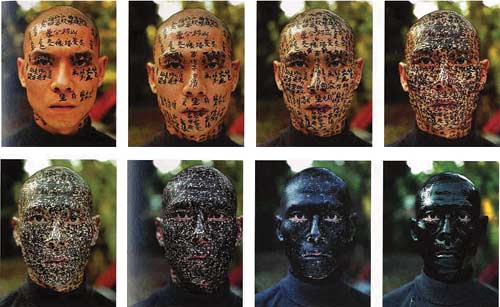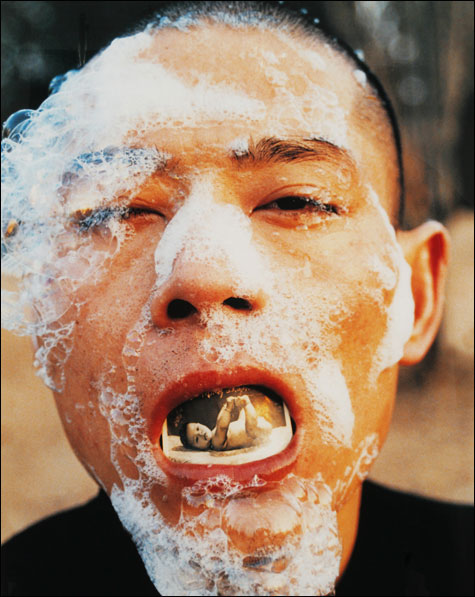Yesterday was the turn of the White Cube in Hoxton Sqare that I hadn't been to in ages, to see Antony Gormleys new sculpures. I've signed up to their newsletter now to keep up as I didn't know they'd opened another one in Bermondsy which is a big simple beautiful space - white walls, polished concrete flaws and huge ceilings of light (not sure if daylight or lighting).
White Cube Hoxton, Bermondsy, Mason's Yard-St James, Hong Kong: http://whitecube.com/
----------------------------------------------------------------------------------------------------------
Antony Gormley - Still Standing @ White Cube, Hoxton
I like Gormley: he places humans in the centre of both seaside/urban/etc landscapes. (eg Angel of the North and Another Place) He has managed to create the emotion of these characters in their individual poses using blocks of steel (the building blocks of life?)
 |
| One of the attendants said she had run in one day dying to use the loo, when she spotted the characters hunched over holding his groin area. |
----------------------------------------------------------------------------------------------------------
http://whitecube.com/exhibitions/zhang_huan_the_mountain_is_still_a_mountain_bermondsey_2012/
I also went down to check out the newish White Cube Bermondsy, their biggest gallery, not knowing if I could make it - but again the Olympics are keeping London's traffic to the level of a midnight run. I was also intrigued by the exhibition of a Chinese artist I'd never heard of - I think contemporary Chinese artists are really creating exciting new and beautiful work.
Wow what a discovery - and there's much to discover. Why didn't I know about him (born '65, graduated 93, exhibiting since '95) I'm obviously not on the cutting edge of what is going on.
here's his site: http://www.zhanghuan.com/
First discover the works in this exhibition
These huge , seemingly (be patient there's more to it) traditional painted copies of old black and white photos, are haunting in themselves - yes I know I'm a sucker for the sadness and nostalgia of old photos of people now long dead - who they were, what life they lead - especially in a very different culture, my own death etc. And, in the wonderful open space of the new gallery they are given the space to breath life.
Then there are the simple names he gives them which you know have more meaning. You get the feeling there is something else going on - 'National Day' showing celebrations in 1959 in Tienanmen Square is obviously more than just what it seems. Even though he doesn't mention the name of the square, it must be obvious to all Chinese at least.
 |
| 'Our Parents' -left. 'National Day' - right. |
 |
| 'Our Parents' - how evocative of what they went through to bring up their children in China and the seriousness one showed in a portrait of a good communist family. |
 |
| 'The Soldier' |
 |
| 'Division Meeting' - left. 'President Yuan' - right. |
'My Literary Teacher'
 |
| 'My Literary Teacher' What wonderful ideas did she impart to her students? |
Then we have a slightly surreal 'Fire'. Is this the destruction of the freedom of the press. Is this man important. You can read up on this or just enjoy the image.
 |
| 'Fire' |
Then you discover the method
Then you realise they have all been created in the incence ash he collected from Budhist temples. He also makes sculptures with it.
From the guide:
'Entitled ‘The Mountain is Still a Mountain’, a reference to the teachings of a Chan Buddhist master from the Tang Dynasty period, this exhibition presents a series of large-scale figurative ash paintings that touch on diverse cultural, political and spiritual themes. Painted from historical photographs taken from old magazines, family albums and the propagandist publications distributed by the government during the Cultural Revolution, their subject matter ranges from depictions of political leaders, such as the influential Nationalist Party members Chiang Kai-shek and Hu Hanmin, important intellectual and religious figures like the writer Wei Wei and the Buddhist scholar Shen-yen to anonymous family portraits and panoramic seascapes. Also included in the exhibition are two monumental paintings of significant historical events; 1959 National Day (2010), a view of Tiananmen square on the anniversary of Mao Zedong’s declaration of the People’s Republic of China, and Grand Canal (2009) showing labourers at work on the Beijing to Hangzhou Canal. Incense ash is a highly charged and significant medium for Zhang. It embodies the harmony and unity of collective religious ceremony as well as the intensely private, individual experience of prayer. Described by the artist as a transformative ‘message carrier’, it is both the residue of disintegrated material – an index of memory, history and the past – and a deeply spiritual signifier of restitution and hope'
Then discover the radical artist - (genious?)
You know someone who can create such works in ash must be intense and obsessive to say the least. The catalogue hints at his work as a performance artist so you know he is no traditionalist. Then I saw a book in the bookshop on his performance pieces using his own body - very good looking he is too - and later on google images. Again from the guide:
'Carrying on from earlier performative works, such as Pilgrimage to Santiago (2001), in which the artist enclosed himself in an immense, swinging thurible, Zhang’s use of ash in these works melds traditional Chinese and Western art historical references with his own complex, personal and religious meanings.'
Images of Huan's wide ranging performance and other work from google images:
 | |||
| Incense ash sculpture |
 |
| '1/2' |
 |
| 'Family Tree' |
 |
| 'To Raise the Water Level in a Fishpond' |
 |
| '12 Square Metres' |
 |
| 'Human Nature' |
 |
| 'Three Legged Buddha' 2008, Royal Academy |
 |
| 'Long Island Buddha' |
----------------------------------------------------------------------------------------------------------
For anyone lucky enough to be in Hong Kong, the Kiefer exhibition would be amazing.



























